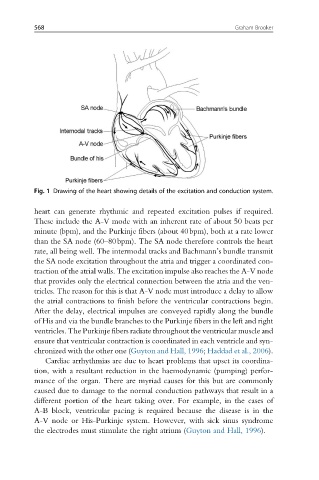Page 575 - Handbook of Biomechatronics
P. 575
568 Graham Brooker
Fig. 1 Drawing of the heart showing details of the excitation and conduction system.
heart can generate rhythmic and repeated excitation pulses if required.
These include the A-V mode with an inherent rate of about 50 beats per
minute (bpm), and the Purkinje fibers (about 40bpm), both at a rate lower
than the SA node (60–80bpm). The SA node therefore controls the heart
rate, all being well. The intermodal tracks and Bachmann’s bundle transmit
the SA node excitation throughout the atria and trigger a coordinated con-
traction of the atrial walls. The excitation impulse also reaches the A-V node
that provides only the electrical connection between the atria and the ven-
tricles. The reason for this is that A-V node must introduce a delay to allow
the atrial contractions to finish before the ventricular contractions begin.
After the delay, electrical impulses are conveyed rapidly along the bundle
of His and via the bundle branches to the Purkinje fibers in the left and right
ventricles. The Purkinje fibers radiate throughout the ventricular muscle and
ensure that ventricular contraction is coordinated in each ventricle and syn-
chronized with the other one (Guyton and Hall, 1996; Haddad et al., 2006).
Cardiac arrhythmias are due to heart problems that upset its coordina-
tion, with a resultant reduction in the haemodynamic (pumping) perfor-
mance of the organ. There are myriad causes for this but are commonly
caused due to damage to the normal conduction pathways that result in a
different portion of the heart taking over. For example, in the cases of
A-B block, ventricular pacing is required because the disease is in the
A-V node or His-Purkinje system. However, with sick sinus syndrome
the electrodes must stimulate the right atrium (Guyton and Hall, 1996).

